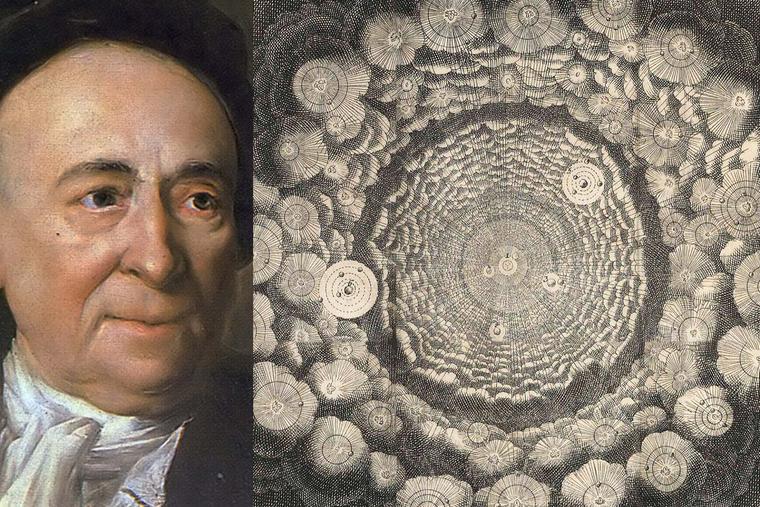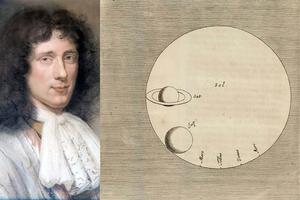Other Earths: The Birth of a Popular (But Not Scientific) Idea
PART II: When thinkers like Fontenelle popularized the idea of a Plurality of Worlds in the 17th century, it grew to be widely supported by astronomers — but science offered nothing to support it, and offered easily reproducible results to question it.

UFOs, ETs and the Strange History of Other Earths
PART I – PART II – PART III – PART IV
Blockbuster movie franchises, media coverage of UFOs and Navy pilots, and claims about what the discovery of “extraterrestrials” would mean for humankind’s place in the universe all hinge on the idea that our universe abounds in other worlds like our Earth. This prominent idea is commonly associated with scientific progress, dating back to Copernicus in the 16th century. But as this four-part series shows, science in fact has never supported this idea of a “Plurality of Worlds.”
* * * * * * *
When Giordano Bruno promoted the idea that the universe was full of other suns, orbited by other earths, the brilliant early-17th-century astronomer Johannes Kepler showed that science proved Bruno wrong, and that there was only one single sun: ours (see Part I in this series). But the idea of stars being suns had appeal, despite Kepler and his appeal to science.
René Descartes (“I think therefore I am”), a younger contemporary of Kepler, helped the idea along a bit when he came up with a theory that provided a physical mechanism to explain why orbits worked (in contrast to Kepler, who developed the mathematics of how they worked). Descartes proposed that the universe was filled with of a sort of fluid matter; all planets, moons and so forth would then be immersed in it. Orbital motion resulted from whirlpools or vortices in this fluid.
Accordingly, planets orbit the sun for the same reason that soap bubbles in water swirling down a fast drain orbit the drain — they are caught in a vortex. The sun sits in the center of a large vortex that carries the planets around it. Jupiter with its four moons and Earth with its one moon sit within smaller vortices that exist within the solar vortex.
Fontenelle and “The Plurality of Worlds”
Several decades after Kepler and Descartes, Bernard Le Bovier de Fontenelle (1657–1757; those dates are correct) borrowed the vortex idea for his 1686 book Entretiens sur la Pluralité des Mondes or Conversations on the Plurality of Worlds. This book gave a great boost to the idea of a universe of other suns and other earths. It featured a frontispiece by Juan d’Olivar, showing the solar system as but one system among a vast swarm of suns and planets.
“French society was shocked,” says the scholar Lucía Ayala, and “this shock quickly spread throughout Europe.”
Conversations was written in the form of a discussion between a narrator and a countess. They discussed how the moon must be inhabited because it is like the Earth, and the planets, too, because they are like the moon. The stars — being “luminous bodies in themselves, and so many suns,” according to the narrator — would be centers of their own myriad vortices, with their own planets featuring inhabitants who are looking out upon the universe just as we do. The universe was filled, as d’Olivar’s illustration showed, with many suns and many earths — filled, that is, with a “Plurality of Worlds” like ours.
No doubt Kepler spun in his grave over Fontenelle saying that the stars are “so many suns.” Fontenelle’s reasoning was none too scientific: because “their light is bright and shining,” he said. He was not writing a work of rigorous science. His narrator claimed, for example, that the interactions between the vortices of the stars was the cause of their twinkling, apparently unaware both that an interested observer can easily ascertain that the twinkling of stars is a phenomenon of Earth’s own atmosphere (twinkling is obviously influenced by the weather), and that this had been fully discussed seven decades earlier by the German astronomer Father Christoph Scheiner of the Society of Jesus (most of the astronomers on the core staff of the Vatican Observatory today are likewise “Jesuits”) and his student Johann Georg Locher.
Conversations may have lacked scientific rigor, but Ayala makes the case that it had a certain political appeal. King Louis XIV of France had embraced Copernicanism as a metaphor for his rule as “The Sun King.” Ayala writes that Louis XIV “undertook many endeavors to convince others of his own conviction: that natural forces legitimized his power, Copernicanism being his major proof.” She illustrates this with the following bit of flattery, written to him in an astronomy book’s preface:
Indeed, Sire, you are at the center of this kingdom as the sun, according to the hypothesis of Copernicus, is at the center of the universe. The respectable serenity, which is always seen glowing on your noble face, in situations when philosophy would be disconcerted, shows us how religion has elevated your sentiments above nature; and to us you are a vivid image of this perfect repose, as Copernicus represents the sun inscribed from the center of the world out to its circumference, whose powerful virtue makes the Earth and all the celestial globes move. Is your state not ordered like the visible world?
This “colonization” of the sun by Louis XIV, Ayala argues, “paved the way for the enthusiastic reception of the idea of the plurality of worlds,” compelling the sun to give up its throne. D’Olivar’s illustration features a face in every one of the innumerable suns. Fontenelle’s book says that our sun is not special, and the universe is not structured around a single, brilliant ruler.
Telescopes and Star Sizes
Fontenelle’s science might have been less persuasive than the idea of taking the Sun King down a notch, but in fact, by the time Conversations was published, science was less solidly against the idea of the stars being suns than it was in Kepler’s time. Kepler’s single-sun universe hinged on the apparent sizes of stars. And while he loved the idea of giant stars (saying that they showed how God could create both the stupendously vast and the brilliantly small, and so on — see Part I in this series), the fact was that giant stars were a giant problem for the supporters of Copernicus.
Anti-Copernicans, dating back to the Danish astronomer Tycho Brahe (Kepler’s one-time boss, whose copious and high-quality data Kepler had used to make his breakthroughs regarding orbits), had argued that the giant stars were an absurdity, a great weakness of the Copernican system. Earth-centered models of the universe did not require stars to be at the vast distances needed by the Copernican model. Lesser distances translated into lesser sizes. In Earth-centered models, stars were commensurate in size with other celestial bodies, like the sun and the larger planets; much more reasonable, said Brahe.
Telescopes, when brought to bear on the star size question early in the 17th century, had seemed to confirm that stars had to be giant under the Copernican model. Various astronomers, including Scheiner and Locher, their fellow German Simon Marius, and the Italian Jesuit Father Giovanni Battista Riccioli, observed stars telescopically, and sided with Brahe. They argued for an Earth-centered model of the universe developed by Brahe that both accommodated new telescopic discoveries and allowed for reasonably sized stars. Telescopic data seemed to oppose the idea that stars were suns, and thus to oppose any Plurality of Worlds.
But by the 1660s some astronomers had begun to publish different lines of evidence suggesting that telescopes radically inflated the apparent sizes of stars. Were this true, stars could be radically smaller. They could be suns.
This evidence was challenged by other astronomers. For example, when the Dutch astronomer Christiaan Huygens published observations suggesting that telescopes inflated the sizes of stars, John Flamsteed, England’s first Astronomer Royal, countered with observations showing just the opposite. Thus when Fontenelle published Conversations in 1686, the question of whether science was against the idea that stars were suns was in flux.
But regardless of the science, enthusiasm for a Plurality of Worlds had caught on. In 1716 and again in 1740, Jacques Cassini of the Paris Observatory published high-quality telescopic measurements of Sirius that showed it to be giant, granted a Copernican universe. Just like Kepler, he showed that all stars had to be giant compared to the sun — that they were not other suns.
It mattered not. Fellow astronomers acknowledged Cassini’s measurements, but nevertheless spoke of the stars as being other suns. John Hill borrowed heavily from Cassini in his 1754 book Urania, and wrote:
The observation of Sirius’s diameter ... had, for its author, one of the most accurate, and most judicious astronomers the world has ever known, Cassini, and, whenever it is repeated with the same apparatus, it succeeds in the same manner, and verified very punctually; and other stars have also apparent diameters of nearly the same extent.
Note the emphasis on the reproducibility of Cassini’s results. Nevertheless, Hill described the stars as being other suns:
The more we see of the works of the creation, the more we must admire and adore its Author. It does appear that the unbounded space is filled at proper distances with these stars: each of these is a sun; and if we continue the inquiry, reasoning by analogy, we shall determine that each of these suns has earthy planets rolling round it, for to what end else should they have been created? In this view, what, and how amazing is the structure of the universe!
Perhaps there was political appeal to a Plurality of Worlds. Perhaps there was religious appeal. Whatever the reason, it was just too appealing of an idea to let a little high-quality, easily-reproducible telescopic data from a highly skilled scientist call it into question.
In time, however, those lines of evidence suggesting that telescopes radically inflated the apparent sizes of stars turned out to be solid. Huygens was right. Flamsteed was wrong — and so were Cassini and Kepler. A full understanding of why had to await the 19th century, when scientists developed a fully functional theory of the wave nature of light. By then the idea of a Plurality of Worlds was broadly accepted.
Further Reading
Ayala, L. (2012, May 23). On the Plurality of Worlds: Images of a New Cosmos. Retrieved December 23, 2021, from University of California Berkely Center for Science, Technology, Medicine, & Society: https://cstms.berkeley.edu/current-events/on-the-plurality-of-worlds-images-of-a-new-cosmos/
Ayala, L. (2015). Cosmology after Copernicus: Decentralisation of the Sun and the Plurality of Worlds in French Engravings. In T. Rahn, C. Zittel, & W. Neuber (Eds.), The Making of Copernicus: Early Modern Transformations of a Scientist and His Science (pp. 201-226). Leiden: Brill.
Graney, C. M. (2021). The Starry Universe of Jacques Cassini: Century-old Echoes of Kepler. Journal for the History of Astronomy, 52(2), 147-167.
- Keywords:
- ufos
- extraterrestrials
- other earths

















